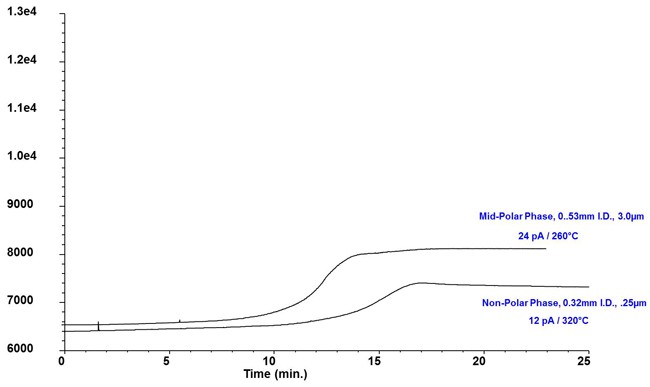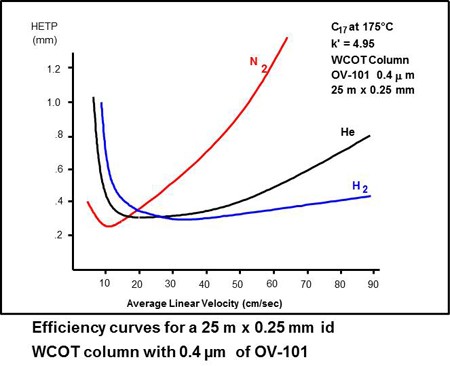GC Glossary
![]()
Bleed: Normal background signal generated by the elution of normal degradation products of the column stationary phase or septum due to high-temperature operation.
Bleed test: acquire a blank run (no injection) using a temperature program. Starting at 40–50°C, ramp 10-20°/min, then hold for 10-15 minutes at the conditioning temperature.

Bonded phase: a stationary phase that has been chemically bonded to the inner column wall (lower bleed, stable efficiency, stable inertness).
![]()
Capacity: the maximum amount (in nanograms) of a single analyte that can be introduced onto a column without the peak distorked.
Column capacity in ng – typical capacity ranges for a variety of column diameter
| Øint (mm)/ Film thickness (µm) | 0.18 - 0.20mm | 0.25mm | 0.32mm | 0.53mm |
| 0.10µm | 20 - 35 | 25 - 50 | 35 - 75 | 50 - 100 |
| 0.25µm | 35 - 75 | 50 - 100 | 75 - 125 | 100 -250 |
| 0.50µm | 75 - 150 | 100 - 200 | 125 - 250 | 250 - 500 |
| 1.00µm | 150 - 250 | 200 - 300 | 250 - 500 | 500 - 1000 |
| 3.00µm | 400 - 600 | 500 - 800 | 1000 - 2000 | |
| 5.00µm | 1000 - 1500 | 1200 - 2000 | 2000 - 3000 |
Conditioning: Condition the column 20°C above the final analysis temperature of your method. Do not exceed the column’s maximum operating temperature.
![]()
Deactivation: permit good chromatography : minimum absorption, symmetric peaks for compounds of interest.
Diameter: inner diameter in mm.
The smaller the diameter the greater the efficiency, hence better resolution.
![]()
Efficiency: Theoretical plate numbers are an indirect measure of peak width for a peak at a specific retention time.
![]()
![]()
Fast GC: decreasing analysis time without loss of component resolution (changing carrier gas, internal diameter, film thickness ancd column length).
Fast column (0.1mm) are used for faster analysis because the same resolution can be achieved in a shorter time.
Ferrules: >>> "Click to packed column"
| Column ID | Ferrules ID |
| 0.10-0.18-0.25 mm | 0.40mm |
| 0.32mm | 0.50mm |
| 0.45-0.53mm | 0.80mm |
Film thickness in µm : for samples with a variation in solute concentration, a thicker film column is recommended.
![]()
Grob test: Universal test for capillary columns.
![]()
Headspace: Volatile solutes equilibrate between the liquid (or solid) sample and the air space above it (headspace) in a sealed vials. At equilibrium, the concentration of analyte in the headspace is proportional to its concentration in solution.
![]()
Kowats Index: describes the retention behavior of a compound relative to that of straight chain hydrocarbons.
Especially important for polar column.
![]()
Length: column length in meter.
Liner: >>> "Click to liner"
![]()
Molecular Sieve: staionnary phase that retains solute by molecular size interactions.
![]()
Number of theoretical plates N:
staionnary phase that retains solute by molecular size interactions.
| Column ID (mm) | N (plates/m) | Theoretical plate numbers are an indirect measure of peak width for a peak at a specific retention time. N =5.545* tr/(w1/2) |
|
| 0.10 | 12 500 | ||
| 0.18 | 6 600 | ||
| 0.20 | 5 940 | ||
| 0.25 | 4 750 | ||
| 0.32 | 3 710 | ||
| 0.45 | 2 640 | ||
| 0.53 | 2 240 |
![]()
Packed column: >>> "Click to packed column"
Plates: see Theoretical plate numbers.
PLOT: Porous Layer Open Tubular.
A capillary column with a modified inner wall that has been etched or
otherwise treated to increase the inner surface area and provide gas-solid chromatographic retention behavior or the stationary phase
is a solid substance that is coated to the column wall.
PLOT columns are intented for the separation of very volatile solutes.
PEG / polyethylene glycol WAX or FFAP are some type of polyethylene glycol.
Phase ratio: ß
Effects of phase film thickness are interdependent with column I.D. The phase ratio, beta (b), expresses the ratio of the gas volume and the stationary phase volume in a column:
![]()
In contrast to relative terms (“thick film” and “thin film”), b values establish a distinct ranking for columns. As a general rule, select columns by b values as follows:
| ß Value | Uses |
| <100 | Highly volatile, low molecular weight compounds |
| 100-400 | General purpose analyses, Wide range of compounds |
| >400 | High molecular weight compounds, Trace analyses |
| ß values are also useful when changing column I.D. and film | |
Polarity: stationnarity phase polarity is determined by the polarity of the substituted group and their relative amounts.
Pressure: Inlet Head Pressure.
| 30m capillary column | Helium (PSI) | Hydrogène (PSI) |
| 0.10 | 225 - 250 | 110 - 125 |
| 0.20 | 25 - 35 | 12 - 18 |
| 0.25 | 15 - 25 | 8 - 12 |
| 0.32 | 10 - 20 | 5 - 10 |
| 0.53 | 2 - 4 | 1 - 2 |
PTV: Programmed temperature Vaporized.
The sample is injected into a cool liner, and then the inlet temperature is increased to vaporize the sample.
![]()
Resolution: RS.
![]()
Retention gap: a short piece of desactived but uncoated column placed between the inlet and the analytical column.
A retention gap often helps relieve solvent flooding. It also retains nonvolatile sample contaminants from on column injection.
Retention factor: the Retention Factor is another measure of retention. It is the ratio of the amount of time
a solute spends in the stationary phase and mobile phase (carrier gas).
![]()
Rinsing columns: Do not solvent rinse non bonded columns.
![]()
Septa ou septum:
Separator factor: α the Separation Factor is a measure of the time or distance between the maxima of two
peaks. If α = 1, the two peaks have the same retention time and co-elute.
![]()
Selectivity:
Solvent expansion volume:
| Solvent Vapor | Volume (µl) |
| Isooctane | 110 |
| n-Hexane | 140 |
| Toluene | 170 |
| Ethyl Acetate | 185 |
| Acetone | 245 |
| Methylene Chloride | 285 |
| Carbon disulfide | 300 |
| Acetonitrile | 350 |
| Methanol | 450 |
| Water | 1010 |
Split injection: sample size is adjusted to suit capillary column requirements by splitting off a major fraction of sample vapors in the inlet so that as 0.1% enters the column. The rest is vented.
Splitless injection: Derivative of split injection. During the first 0.5 to 4 minutes of the sampling the sample is not split, and enters only the column. Spliiting is restored afterwards to purge sample remaining in the inlet. Up to 99% of sample enters the column.
Split ratio: the ratio of the sample amount vented to the sample amount entering the column in split injection. Higher split ratios place less sample on the column. Usually measured as the ratio of total inlet flow to column flow.
Stationnary phase: select the least polar phase that will perform the separation you require.
Storage: seal the column ends with inert end caps and return to the original box.
Syringe:
![]()
T0: time for unretained compound.
Temperature: operating temperature.
| -60 | To | 320 | / | 340 |
| Minimum temperature | Maximun temperature Operating temperature |
Maximum cycling temperature for short periods (up to 30min) |
![]()
Unretained compounds:
| Detectors | Compounds |
| FID | Methane, Butane |
| TCD | Methane, Butane, Argon, Air |
| NPD | Acetonitrile vapor (headspace) |
| ECD | Methylene chloride vapors (headspace) |
| ELCD | Duchlorodifluoromethane vapors |
| MS | Air, Methane, Butane, Argon |
| PID | ethylene |
![]()
Velocity: “speed” of the carrier gas in cm/sec (centimeters of column traveled per second by a carrier gas molecule)
U = L / t0
L: column length
t0: retention time of an unretained peak (sec).

Van Deemter equation: H=A+B/u+Cu
![]()
WCOT: wall Coated Open Tubular.
The stationary phase is a liquid film coated to the desactived wall of the column.